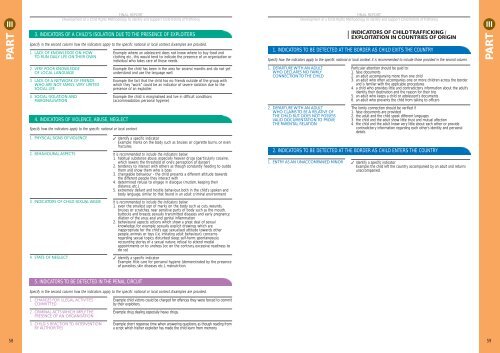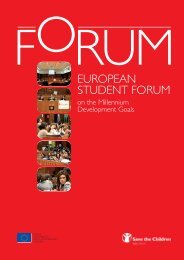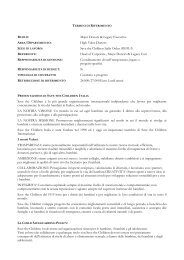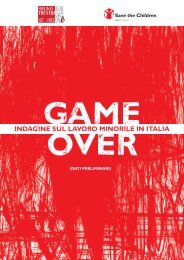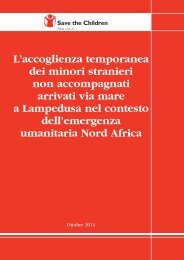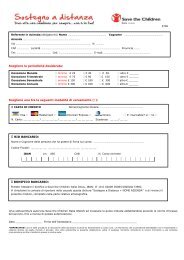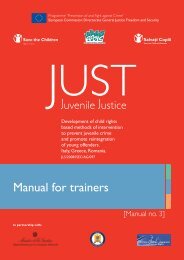FINAL REPORT - Save the Children Italia Onlus
FINAL REPORT - Save the Children Italia Onlus
FINAL REPORT - Save the Children Italia Onlus
You also want an ePaper? Increase the reach of your titles
YUMPU automatically turns print PDFs into web optimized ePapers that Google loves.
IIIPART<strong>FINAL</strong> <strong>REPORT</strong>Development of a Child Rights Methodology to Identify and Support Child Victims of Trafficking3. INDICATORS OF A CHILD’S ISOLATION DUE TO THE PRESENCE OF EXPLOITERSSpecify in <strong>the</strong> second column how <strong>the</strong> indicators apply to <strong>the</strong> specific national or local context. Examples are provided.1. LACK OF KNOWLEDGE ON HOWTO RUN DAILY LIFE ON THEIR OWNExample: where an adolescent does not know where to buy food andclothing etc., this would tend to indicate <strong>the</strong> presence of an organisation orindividual who takes care of those needs.<strong>FINAL</strong> <strong>REPORT</strong>Development of a Child Rights Methodology to Identify and Support Child Victims of TraffickingINDICATORS OF CHILD TRAFFICKING /EXPLOITATION IN COUNTRIES OF ORIGIN1. INDICATORS TO BE DETECTED AT THE BORDER AS CHILD EXITS THE COUNTRYSpecify how <strong>the</strong> indicators apply to <strong>the</strong> specific national or local context. It is recommended to include those provided in <strong>the</strong> second column.IIIPART2. VERY POOR KNOWLEDGEOF LOCAL LANGUAGE3. LACK OF A NETWORK OF FRIENDSWHO ARE NOT FAMILY; VERY LIMITEDSOCIAL LIFE4. SOCIAL ISOLATION ANDMARGINALISATIONExample: <strong>the</strong> child has been in <strong>the</strong> area for several months and do not yetunderstand and use <strong>the</strong> language well.Example: <strong>the</strong> fact that <strong>the</strong> child has no friends outside of <strong>the</strong> group withwhich <strong>the</strong>y “work” could be an indicator of severe isolation due to <strong>the</strong>presence of an exploiter.Example: <strong>the</strong> child is marginalised and live in difficult conditions(accommodation, personal hygiene).1. DEPARTURE WITH AN ADULTWHO DECLARES NO FAMILYCONNECTION TO THE CHILDParticular attention should be paid to:1. false documents2. an adult accompanying more than one child3. an adult who often accompanies one or more children across <strong>the</strong> borderand is familiar with <strong>the</strong> applicable procedures4. a child who provides little and contradictory information about <strong>the</strong> adult’sidentity, <strong>the</strong>ir destination and <strong>the</strong> reason for <strong>the</strong>ir trip5. an adult who keeps a child or adolescent’s documents6. an adult who prevents <strong>the</strong> child from talking to officers4. INDICATORS OF VIOLENCE, ABUSE, NEGLECTSpecify how <strong>the</strong> indicators apply to <strong>the</strong> specific national or local context.1. PHYSICAL SIGNS OF VIOLENCE2. BEHAVIOURAL ASPECTS✓ Identify a specific indicatorExample: marks on <strong>the</strong> body such as bruises or cigarette burns, or evenfractures.It is recommended to include <strong>the</strong> indicators below:1. habitual substance abuse, especially heavier drugs (particularly cocaine,which lowers <strong>the</strong> threshold of one’s perception of danger)2. tendency to interact with o<strong>the</strong>rs as though constantly needing to outdo<strong>the</strong>m and show <strong>the</strong>m who is boss3. changeable behaviour - <strong>the</strong> child presents a different attitude towards<strong>the</strong> different people <strong>the</strong>y interact with4. determined refusal to engage in dialogue (mutism, keeping <strong>the</strong>irdistance, etc.)5. extremely defiant and hostile behaviour, both in <strong>the</strong> child’s spoken andbody language, similar to that found in an adult criminal environment2. DEPARTURE WITH AN ADULTWHO CLAIMS TO BE A RELATIVE OFTHE CHILD BUT DOES NOT POSSESSVALID DOCUMENTATION TO PROVETHE PARENTAL RELATIONThe family connection should be verified if:1. false documents are provided2. <strong>the</strong> adult and <strong>the</strong> child speak different languages3. <strong>the</strong> child and <strong>the</strong> adult show little trust and mutual affection4. <strong>the</strong> child and <strong>the</strong> adult know very little about each o<strong>the</strong>r or providecontradictory information regarding each o<strong>the</strong>r’s identity and personaldetails2. INDICATORS TO BE DETECTED AT THE BORDER AS CHILD ENTERS THE COUNTRY1. ENTRY AS AN UNACCOMPANIED MINOR ✓ Identify a specific indicatorExample: <strong>the</strong> child left <strong>the</strong> country accompanied by an adult and returnsunaccompanied.3. INDICATORS OF CHILD SEXUAL ABUSEIt is recommended to include <strong>the</strong> indicators below:1. even <strong>the</strong> smallest sign of marks on <strong>the</strong> body such as cuts, wounds,bruises or scratches, near sensitive parts of body such as <strong>the</strong> mouth,buttocks and breasts; sexually transmitted diseases and early pregnancy;dilation of <strong>the</strong> anus; anal and genital inflammation2. behavioural aspects: actions which show a great deal of sexualknowledge, for example: sexually explicit drawings which areinappropriate for <strong>the</strong> child’s age; sexualised attitude towards o<strong>the</strong>rpeople, animals or toys (i.e. imitating adult behaviour); concernsregarding sexual topics; disturbed sleep; self-harm; spontaneouslyrecounting stories of a sexual nature; refusal to attend medialappointments or to undress (or, on <strong>the</strong> contrary, excessive readiness todo so)4. STATE OF NEGLECT✓ Identify a specific indicatorExample: little care for personal hygiene (demonstrated by <strong>the</strong> presenceof parasites, skin diseases etc.), malnutrition.5. INDICATORS TO BE DETECTED IN THE PENAL CIRCUITSpecify in <strong>the</strong> second column how <strong>the</strong> indicators apply to <strong>the</strong> specific national or local context. Examples are provided.1. CHARGES FOR ILLEGAL ACTIVITIESCOMMITTED2. CRIMINAL ACTS WHICH IMPLY THEPRESENCE OF AN ORGANISATION3. CHILD’ S REACTION TO INTERVENTIONBY AUTHORITIESExample: child victims could be charged for offences <strong>the</strong>y were forced to commitby <strong>the</strong>ir exploiters.Example: drug dealing, especially heavy drugs.Example: short response time when answering questions, as though reading froma script which his/her exploiter has made <strong>the</strong> child learn from memory.5859


